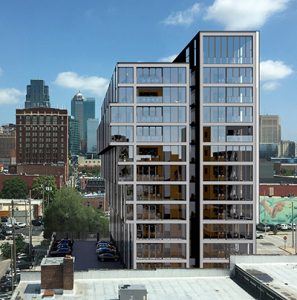Look beyond traditional amenities for multifamily
“Rooftop pool!” “On-site fitness center!”
Traditional multifamily amenities like fancy gyms and state-of-the-art theater rooms may still be popular across the variety of apartment buildings and condos in Kansas City, but the growing appeal of mixed-use neighborhoods is changing the way we approach a new project.
From shifting demographics to a major evolution in retail, the multifamily industry is finally ready to catch up.
Multifamily community-building
We’ve all watched retail reinvent itself in recent years, adding experiential attractions to drive customers through the door (and not to their phones). The multifamily market is taking a similar approach, especially as tenant demographics evolve as well.
While we know that Millennials are staying in apartments longer and Boomers are downsizing, we’re also preparing for the rise of the generation coming next. Generation Z – those born between 1996 and 2010 – are starting to enter the workforce and find that first apartment. One trait this generation tends to share with many of the Millennials before them is a focus on community—which means new multifamily projects must find ways to not only build that sense of community but also build on the existing one of the surrounding area.
Barbara Ballinger explains in Realtor Magazine why developers need to find ways to “bring in the neighborhood.”
“Location has always been important to developers, but now the businesses nearby a residential unit are becoming more important to the site choice process … Besides locating their buildings near retail services and offices, more developers and property managers are working directly with neighborhood experts to build synergy. Such strategies can boost both the building’s and the retailer’s visibility.”
Proximity is important, of course, but property managers also have an opportunity to weave in neighborhood amenities more directly. This can be anything from partnering with a local wine bar for a tasting event at your building or working out a discount for tenants at the local furniture store.
As we finalized the plans for REVERB, a new apartment building at 18th and Walnut streets in the Crossroads, we knew there was a lot of intrinsic value already built into the neighborhood. So, instead of spending development budget dollars on expensive building amenities that sometimes don’t get used – either because of a lack of interest or for seasonal reasons – we’ll be able to redirect those dollars into upgraded finishes in the units.
Refreshing retail
Mixed-use is also forming a symbiotic relationship with retail, to the benefit of both. To keep up with the need for immediacy driving today’s buying habits, retail is finding an answer with the built-in audience provided by mixed-use. That constant foot traffic past a residential property means retailers have a head start on building a customer base—capturing what’s right in front of them instead of trying to tempt customers to go out of their way to come to them.
By incorporating retail that matches the wants and needs of the neighborhood into the multifamily project, we’re able to create a unique building amenity that tenants are looking for. Plus, retail is open to the public (versus private amenities open only to residents), so those shops can also drive awareness and traffic to the apartment building.
When you boil it down, it really comes to understanding your audience and what amenities they really want. Renee Gastineau at Paladino explains that property owners and managers simply have to be nimble:
“The next generation of renters will have their own ideas of which amenities make an apartment community a home. Real estate operators that focus on why certain amenities like community space, dog runs, and exercise options are important to today’s renters will have an advantage. Successful developers will focus on the psychographics – the attitudes and aspirations – of their tenants rather than chasing the next Instagrammable experience.”
No, fancy fitness centers aren’t going anywhere, but as we’ve learned with the opening of Arterra or working on City Center Lenexa, tenants are looking beyond just the four walls of their apartment building as they make their decision. Smart developers must expand their vision as well.
Jon Copaken is Principal at Copaken Brooks, a full-service commercial real estate firm headquartered in Kansas City and serving the Midwest. The company’s full suite of services includes: construction management, leasing (office, medical, retail and industrial), investment acquisition and sales, tenant representation and HQ relocations, condo management, property management, asset management, and development. Share your thoughts on our Facebook page or on Twitter @CopakenBrooks.








